Canvases by Style
Posters by Styles
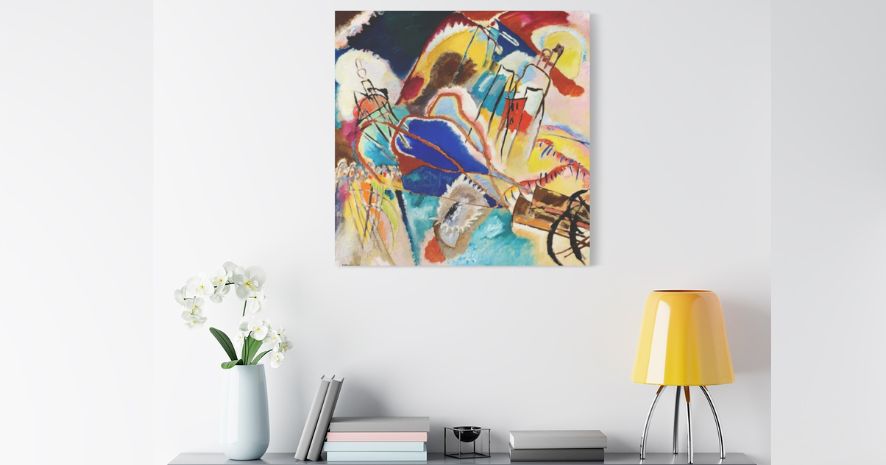
Abstract art has been a significant movement in the art world for over a century, representing a departure from traditional representational art. Abstract paintings are characterized by a focus on color, form, and texture rather than realistic depictions of objects or figures. The development of abstract art was a revolutionary moment in the history of art, challenging traditional notions of what art should be and opening up new possibilities for artists to express themselves.
In this blog post, we will explore some of the most famous abstract paintings of all time. From the bold and colorful compositions of Wassily Kandinsky to the ethereal works of Mark Rothko, these paintings have captivated audiences for decades and continue to inspire new generations of artists. We will delve into the history and meaning behind each painting, as well as the unique techniques and styles employed by each artist. Whether you are a seasoned art aficionado or simply curious about the world of abstract art, this post is sure to provide you with a deeper appreciation for this influential art movement.
Wassily Kandinsky’s “Untitled (First Abstract Watercolor)” is a seminal work in the development of abstract art. Created in 1910, it is considered to be one of the earliest purely abstract paintings in the history of art. At first glance, the painting appears to be a chaotic arrangement of vibrant colors and shapes. However, upon closer inspection, one can discern a sense of movement and rhythm within the composition.
Kandinsky believed that art should be free from the constraints of representation and instead express the artist’s inner emotions and spiritual ideals. “Untitled (First Abstract Watercolor)” embodies this philosophy, with its swirling forms and intense hues conveying a sense of dynamic energy and emotional intensity. For Kandinsky, color was not merely decorative, but rather a means of evoking spiritual and emotional states in the viewer. This painting is a testament to the power of abstract art to transcend traditional artistic boundaries and evoke a sense of the sublime.
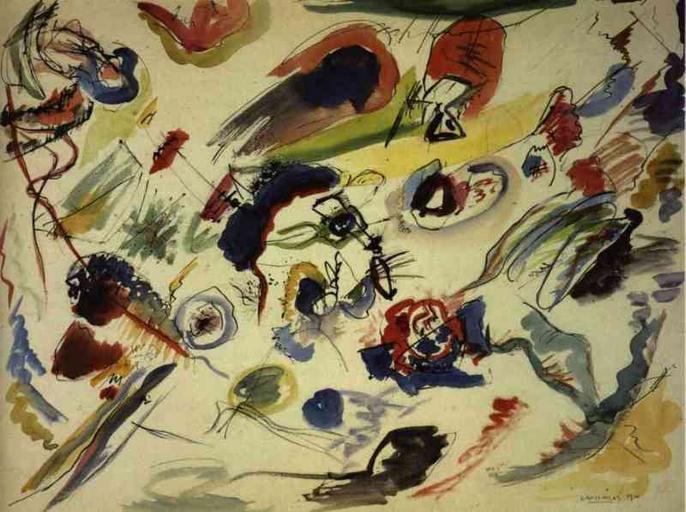
“Convergence” by Jackson Pollock is a seminal work in the development of Abstract Expressionism, a movement that prioritized the act of creation and the artist’s gesture over traditional representation. Created in 1952, the painting is a massive, chaotic canvas filled with layers of drips, splatters, and spatters of paint. The painting is full of energy and movement, with no clear focal point, inviting the viewer to engage with the painting on a visceral level.
Pollock believed in the power of art to express the unconscious mind, and “Convergence” is a prime example of this belief. Through his gestural marks and drips, Pollock allowed his subconscious mind to guide his hand, creating a painting that is both chaotic and controlled. The work is a visual representation of the artist’s innermost thoughts and emotions, and as such, has been interpreted as an abstract self-portrait. “Convergence” remains an iconic work of Abstract Expressionism and expresses the power of the artist’s gesture to evoke powerful emotions in the viewer.
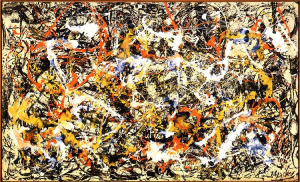
“Tableau I” by Piet Mondrian is a seminal work in the development of abstract art, specifically the style known as De Stijl, which was focused on achieving a universal language of form and color. Created in 1921, the painting is composed of a grid of black lines and primary colors (red, yellow, and blue), with white space in between. The composition is deliberately balanced and symmetrical, with the colors and lines carefully arranged to create a sense of harmony and equilibrium.
Mondrian believed that art should reflect the underlying principles of the universe, and “Tableau I” embodies this philosophy. The painting is an expression of the artist’s quest for purity and order, a visual representation of the balance between opposing forces such as light and dark, and horizontal and vertical lines. Through his use of color and form, Mondrian sought to create a kind of visual harmony that would appeal to the viewer on a fundamental level. “Tableau I” remains a seminal work in the history of abstract art and a showcase of the power of simplicity and balance in creating powerful and evocative compositions.
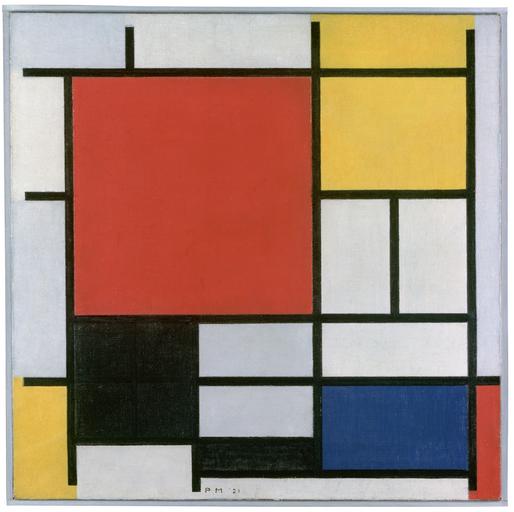
“Peinture (Etoile Bleue)” by Joan Miro is a seminal work in the development of Surrealism, a movement that sought to explore the subconscious mind through art. Created in 1927, the painting is composed of a series of abstract shapes and lines in vibrant colors, centered around a large blue star. The composition is deliberately playful and whimsical, with elements that appear to be both figurative and abstract.
Miro believed that art should be free from the constraints of traditional representation and instead express the artist’s innermost thoughts and emotions. “Peinture (Etoile Bleue)” embodies this philosophy, with its seemingly random shapes and colors expressing a sense of childlike wonder and imagination. The painting is a visual representation of the artist’s inner world, a dreamlike landscape full of mystery and possibility. “Peinture (Etoile Bleue)” remains a seminal work in the history of Surrealism.
“1934 (Relief)” by Ben Nicholson is a seminal work in the development of abstract art, specifically the style known as Constructivism. Created in 1934, the painting is a relief sculpture composed of geometric shapes in various shades of white and gray. The composition is deliberately austere and minimal, with the shapes carefully arranged to create a sense of order and harmony.
In creating “1934 (Relief),” Nicholson sought to distill art down to its most fundamental components, emphasizing purity and simplicity in his work. He arranged the geometric shapes in a deliberate and precise manner, carefully balancing positive and negative space, as well as light and shadow, to create a composition that was visually harmonious. By employing simple shapes and subdued colors, Nicholson aimed to create a work of art that was both elegant and understated, but also intellectually and aesthetically engaging. The painting stands as a testament to the power of minimalism and the importance of form and structure in abstract art.
“Mountains and Sea” by Helen Frankenthaler is a seminal work in the development of Color Field painting, a style that prioritizes the use of color and gesture to create powerful and evocative compositions. Created in 1952, the painting is composed of large areas of color, applied with a technique known as “soak staining,” in which diluted paint is poured directly onto unprimed canvas. The resulting colors blend and bleed into one another, creating a sense of depth and movement on the canvas.
Frankenthaler believed in the power of color to express emotion and mood, and “Mountains and Sea” embodies this philosophy. The painting is an expression of the artist’s experience of nature, specifically the landscape of Cape Breton, Nova Scotia. Through her use of color and technique, Frankenthaler sought to capture the essence of the landscape, creating a painting that is both abstract and evocative. “Mountains and Sea” remains a seminal work in the history of Color Field painting and a testament to the power of color and gesture to create powerful and moving works of art.
“White Center (Yellow, Pink and Lavender on Rose)” by Mark Rothko is a prime example of the artist’s signature style, which came to be known as Color Field painting. Created in 1950, the painting consists of three rectangular blocks of color – white at the center, flanked by bands of yellow and pink above and below, and lavender and rose on either side. The colors are blended in such a way as to create a subtle, luminous effect that appears to glow from within.
Rothko saw his art as a means of expressing deep, primal emotions, and “White Center” is no exception. The painting is an expression of the artist’s innermost feelings, a representation of his search for meaning and transcendence in the face of the chaos of the modern world. The subtle, shifting hues of the painting invite the viewer to contemplate the mysteries of existence and the power of color to evoke emotion and transcendence.
“No. 61 (Rust and Blue)” by Mark Rothko is a masterful example of the artist’s signature style, which came to be known as Color Field painting. Created in 1953, the painting is composed of two large, rectangular blocks of color – a deep, earthy rust color on top, and a rich, cool blue on the bottom. The edges of the blocks are blurred and softened, creating a sense of depth and movement on the canvas.
Rothko saw his art as a means of expressing deep, primal emotions, and “No. 61 (Rust and Blue)” is no exception. The painting is an expression of the artist’s innermost feelings, a representation of his search for meaning and transcendence in the face of the chaos of the modern world. The juxtaposition of the warm, earthy rust color with the cool, serene blue creates a tension that evokes a sense of longing and contemplation.
“Elegy to the Spanish Republic No. 110” by Robert Motherwell is a poignant and evocative work of art that pays tribute to the Spanish Republic, which was overthrown by the Nationalist forces of General Francisco Franco in the Spanish Civil War. Created in 1971, the painting is composed of two large black rectangles, which dominate the canvas, and a smaller rectangle of ochre color that is positioned in the left corner. The edges of the rectangles are rough and uneven, creating a sense of depth and texture on the canvas.
Motherwell was deeply affected by the violence and tragedy of the Spanish Civil War, and “Elegy to the Spanish Republic No. 110” is an expression of his grief and outrage at the loss of life and the destruction of a democratic government. The painting is a visual representation of the horrors of war, and the stark contrast between the black and ochre rectangles evokes a sense of mourning and remembrance. “Elegy to the Spanish Republic No. 110” remains a powerful and moving work of art, a testament to the enduring impact of war and the human spirit.
“Composition VII” by Wassily Kandinsky is one of the artist’s most famous works, created in 1913 during his time with the Blue Rider group. The painting is a riot of color and abstract forms, with interweaving shapes and lines that create a sense of energy and movement. The painting is primarily composed of triangles, circles, and lines, which are arranged in a dynamic and asymmetrical composition.
Kandinsky believed that art should be a reflection of the innermost emotions and spirit, and “Composition VII” is an expression of this philosophy. The painting is a visual representation of the spiritual chaos and upheaval that Kandinsky saw in the world around him, with the complex interplay of shapes and colors representing the clash and conflict of ideas and emotions. The painting invites the viewer to contemplate the mysteries of existence and the power of abstract forms to evoke emotion and transcendence.
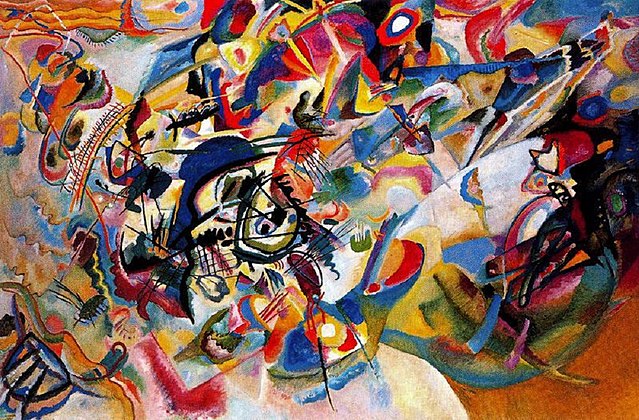
“Senecio” by Paul Klee is a seminal work of modern art, created in 1922 during the height of the artist’s career. The painting depicts a stylized face of a person, composed of a series of geometric shapes, lines, and colors. The face is split down the middle, with each half painted in a different color and pattern. The features of the face are simplified and abstracted, creating a sense of ambiguity and mystery.
Klee believed that art should be a means of expressing the innermost feelings and emotions of the artist, and “Senecio” is an expression of this philosophy. The painting is a representation of the artist’s own psyche, with the split face and simplified features symbolizing the fragmented and multifaceted nature of the self. The use of geometric shapes and abstract forms reflects Klee’s interest in the principles of harmony and balance, and the bold use of color creates a sense of vitality and energy on the canvas.
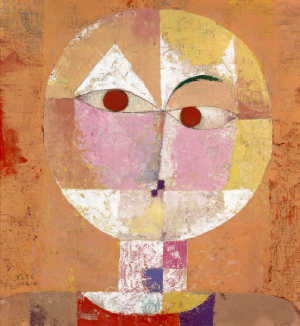
“La Mancha Roja” or “The Red Spot” is a surrealist painting by Joan Miró, created in 1925. The painting depicts a red spot surrounded by a series of organic and abstract forms, set against a orange background. The red spot is the focal point of the painting, drawing the eye and creating a sense of tension and mystery. The organic forms surrounding the spot are highly stylized and suggest the possibility of living organisms or an internal landscape.
Miró believed that art should be a means of exploring the subconscious and the world of dreams, and “La Mancha Roja” is an expression of this philosophy. The painting is a visual representation of the artist’s own inner world, with the red spot representing a focal point of energy or power. The organic forms suggest the possibility of life or growth, while the blue background creates a sense of expansiveness and freedom. “La Mancha Roja” remains a seminal work of surrealism, a testament to the power of the subconscious to inspire and provoke the imagination.
“Composition II in Red, Blue, and Yellow” by Piet Mondrian is a seminal work of abstract art, created in 1930. The painting is composed of a series of squares and rectangles in red, blue, and yellow, arranged in a grid pattern. The colors are flat and unmodulated, creating a sense of pure, non-representational form. The painting’s strict geometry and limited palette reflect Mondrian’s interest in the principles of harmony, balance, and simplicity.
Mondrian believed that art should be a means of achieving spiritual harmony and that pure abstraction was the highest form of expression. “Composition II in Red, Blue, and Yellow” is an expression of this philosophy, a distillation of form and color that creates a sense of transcendent order. The painting is a visual representation of the artist’s own spiritual quest, a search for the underlying principles of the universe that transcends the material world.
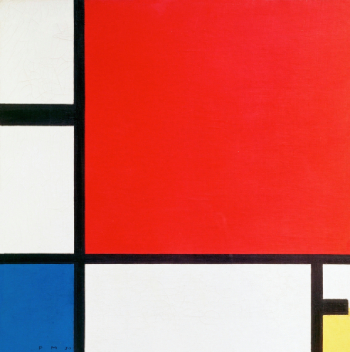
“The Black Square” by Kazimir Malevich is one of the most important works of abstract art ever created. Painted in 1915, it is a square canvas painted entirely in black, with no representational content whatsoever. Malevich saw the painting as the ultimate expression of his concept of “suprematism,” an art movement that sought to create a new visual language that could capture the essence of the modern age.
For Malevich, “The Black Square” represented a rejection of traditional art and a new beginning for the visual arts. The painting was meant to be the ultimate expression of pure form, stripped of all unnecessary content and representing the absolute essence of art. The black square was intended to be a symbol of the void, a representation of the ultimate nothingness that could be transformed into a new, pure form of expression. In this way, Malevich’s painting was a bold statement about the future of art and its potential to evolve beyond the limitations of the past.
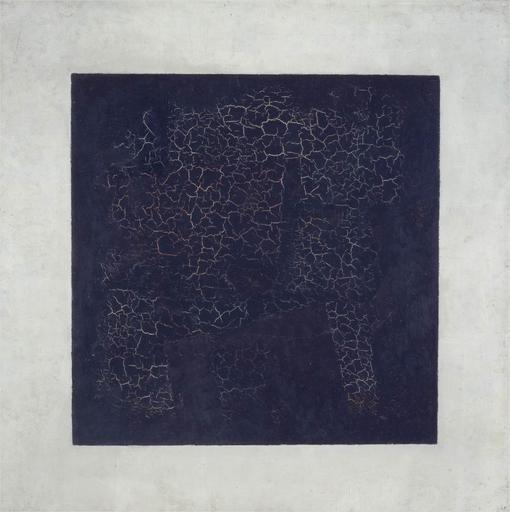
“180 Farben (180 Colours)” by Gerhard Richter is a large-scale abstract painting created in 1971. The painting is made up of 180 different squares, each one a different color. The colors are arranged in a grid pattern, creating a sense of order and harmony. Richter’s use of color is highly controlled and deliberate, with each square carefully chosen to create a sense of balance and unity across the entire composition.
The painting is a powerful statement about the nature of color and its ability to create emotion and meaning. Richter’s use of color is highly expressive, with each square evoking a different mood or feeling. The colors are vibrant and intense, with each one contributing to the overall sense of energy and vitality in the painting. “180 Farben (180 Colours)” is a testament to the power of color to create meaning and emotion, and to the ability of abstract art to transcend traditional representational modes of expression.
In conclusion, abstract art has been a fundamental part of the art world for more than a century. Artists like Wassily Kandinsky, Jackson Pollock, Piet Mondrian, and Mark Rothko have created some of the most famous and influential abstract paintings of all time. These works have challenged traditional notions of representation, encouraging viewers to engage with the emotional and expressive qualities of color, shape, and form.
Abstract art has continued to evolve and thrive in the contemporary era, with artists like Gerhard Richter and Joan Miro pushing the boundaries of the medium with their innovative approaches to color and composition. The legacy of these artists continues to inspire new generations of artists and art lovers, encouraging us to explore the limitless potential of abstraction as a means of creative expression.
Whether we are drawn to the bold, dynamic energy of Pollock’s “Convergence,” or the serene simplicity of Mondrian’s “Tableau I,” abstract art continues to challenge us to see the world in new and unexpected ways, inspiring us to connect with our own inner experiences and emotions.